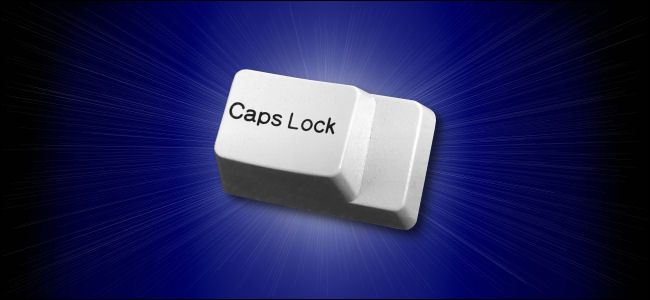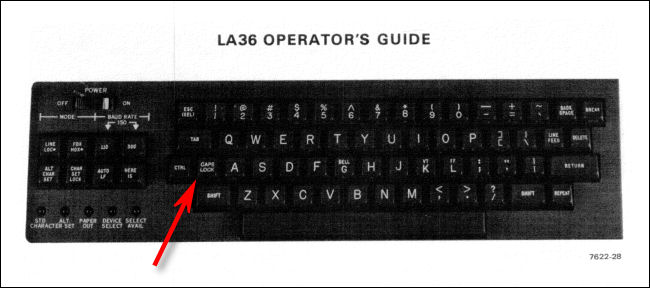
The History of Caps Lock: Why Does the Caps Lock Key Exist?

Caps Lock: the key that MAKES YOU SHOUT ACCIDENTALLY when you press it. Do we really need it in this day and age? Why is it even there, anyway? Let’s find out.
It All Began in the Typewriter Era
Way back in the olden days, most typewriters only produced capital letters. In the 1870s, typewriter manufacturer Remington figured out an economical way to type both upper- and lowercase letters. It did so by placing two symbols or letters (such as upper and lower case) on each typebar—the piece of metal that struck the letters onto the paper.
To switch between the two symbols, you used a Shift key, which physically moved the entire type bar apparatus. This enabled a different portion of the typebar to strike the ribbon and produce a different letter.
Because the Shift key required a relatively large amount of mechanical force to use, it could be fatiguing to hold it down continuously to type in all caps. To fix this, Shift Lock was invented. This was basically a latching key that held the shifting mechanism in place. It was often just labeled “Lock.”
Shift Lock Becomes Caps Lock
On typewriters, the Shift Lock modified the function of every key, including letters (from lower- to uppercase) and other characters, as well (such as numbers into symbols).
In the computer era, though, keyboards no longer physically moved type bars, so keyboard locks were free to diversify. Some terminal and computer keyboards retained the Shift Lock key, while others included a new key called “Caps Lock.” This key only changed lowercase letters to uppercase and didn’t affect any other keys.

According to this anti-Caps Lock article by Daniel Colin James, the original invention of Caps Lock seems to be linked to this 1968 Patent, which applies to an electronic terminal keyboard invented by Douglas A. Kerr of Bell Labs.
James interviewed Kerr, who said he invented the “Caps” key because his boss’s secretary was frustrated by typing strings of characters like “@#$%” instead of numbers when Shift Lock was enabled.
But patents don’t always translate into real products. The earliest record we could find of an actual Caps Lock key on a commercial product was the keyboard built into the LA36 DECwriter II terminal/teleprinter. Announced in 1974, it was a teletype and computer printer rolled into one.
The LA36 DECwriter II’s service manual describes Caps Lock (on page 1-1) as a way to reduce the 96 upper- and lowercase character set into a set of 64 uppercase characters. Originally, you were only able to set this internally via a switch on a circuit board. This suggests that permanent capital-letter production was a desirable feature at the time. This might have been because people were accustomed to the all-caps style of many earlier teletypes.
There might be an earlier example of Caps Lock yet to be rediscovered, however. It’s unclear to what extent DEC was influenced by Kerr’s patent (if it was at all). It’s possible the DEC’s Caps Lock just originated as a compatibility feature to imitate the all-caps behavior of older teletypes.
Caps Lock in the PC Era
Several early home computers in the 1970s, such as the Apple II and the TRS-80 Model 1, didn’t support lowercase letters, so there was no need for a Caps Lock. However, IBM terminals, which borrowed heavily from the IBM Selectric typewriter layout, often included a Shift Lock, and later, a Caps Lock key.
When IBM created its Personal Computer in 1981, it included a Caps Lock key, but IBM positioned it just to the right of the space bar—relatively out of the way. To the left of the A key, you’d find the Control key instead. This placement had been common on the all-caps terminal and teletype keyboards.

In 1984, when IBM converted its keyboard layout to the 101-key Extended Keyboard (aka the Model M), it placed the Caps Lock key to the left of A, and some people still angrily complain about it to this day.
Now that we know about Kerr’s patent and the DECWriter II, we can see that IBM actually just restored Caps Lock to its original position. Unfortunately, that position is a prominent one, so people often accidentally press Caps Lock and type SHOUTY WORDS. It also disrupts the typing of case-sensitive passwords.
As we’ll see, though, there are actually some good reasons why the Caps Lock key is still around.
People Still Use Caps Lock
While many people complain about Caps Lock, others still use it in business to save time and effort. Some of the most common uses include:
- Report headers: This is a throwback to the typewriter era when different fonts were unavailable.
- Serial or VIN numbers: Many of these contain only capital letters.
- Legal agreements: Lawyers have used all-caps in legal documents since the typewriter era to make important terms more conspicuous.
- To label elements in architectural plans: Architects have done this since the days of handwritten letters. Today, they still use handwriting-like architectural fonts in CAD programs.
Beyond these more high-profile uses, there’s also the issue of backward compatibility. For example, a feature that was present on IBM’s 1981 5150 PC is likely still around in case a legacy application still uses it.
How to Type in All Caps Without Using Caps Lock
If you do frequently type in all caps, but dislike using Caps Lock (or the key is missing), you’re in luck. Most word processing programs allow you to type text normally, select it, and then apply an all-caps style. Here’s how to do that in a few common applications:
- Microsoft Word: Select the text you want in all-caps, and then press Control+Shift+A on Windows, or Command+Shift+A on Mac.
- Google Docs: Highlight the text you want to change, and then select Format > Text > Capitalization > UPPERCASE in the menu bar.
- Pages: Highlight the text you want to change, and then select Format > Font > Capitalization > All Caps in the menu bar.
You can also reassign the Caps Lock key to perform another function (such as Control), use it as a modifier key in Windows 10, or disable it completely.
While a lot of folks might never need it, Caps Lock isn’t useless. As we noted above, many people still use it at work, so it’ll likely be with us for decades to come.







Leave a reply